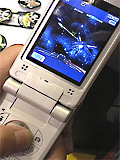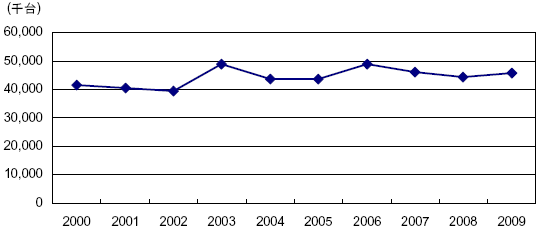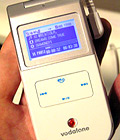Vodafone Flips for Felica in 3G Fall/Winter Lineup

Vodafone follows DoCoMo and KDDI into the brave new revenue world of Osaifu Keitai [wallet phone] introducing its first Felica-equipped handset at a press conference for the Japanese carrier’s Fall/Winter 3G lineup [.PDF]. Four handsets: the 702NK II from Nokia, 703SHf and 604SH both from Sharp plus the 703N by NEC are scheduled for release in October and November. The company is counting on this lineup’s smooth design esthetics, sophisticated hardware and contents to re-ignite consumer interest in the Vodafone brand.
At just 47mm wide the 703SHf is Vodafone’s slimmest 3G handset yet. Besides Felica it has a 1.3 megapixel camera, 2-inch ASV LCD screen and the music player supports AAC and SD-Audio MP3 music files. But who cares. It’s really all about the chip. The Felica IC chip system developed by Sony allows users to swipe Felica-equipped mobile handsets over designated readers and pay for everything from a bottle of ice tea to an airline ticket. DoCoMo started loading it onto their 3G phones in July 2004 and has sold around 5 million Felica-equipped phones so far. The other carriers have seen little choice but to follow. These Sony IC chips have become ubiquitous not by Felica but through the Suica JR train commuter cards which can also be used at shops inside designated train stations and at platform kiosks. Thanks to DoCoMo, Suica is going mobile next year and there are plans to incorporate private train lines and subways into the Suica system as well. KDDI began selling their first Felica handset, the W32S from Sony Ericcson, this month.




 Japan’s lost souls and the musically minded are targets for two new W-CDMA 3G handsets from Vodafone Japan, the 903T and 803T, both by Toshiba. Scheduled for an October release, the 903T finally puts Vodafone on the real-time mobile GPS navigation map (rivals DoCoMo and KDDI have had network GPS phones for some time). Vodafone’s “Live Navi” navigation portal goes the competition one better with the addition of GPS global roaming options in the UK, Hong Kong, Holland, Spain and Germany — with more countries to follow. Of course, international roaming and Vodafone live! communication charges will apply, which might make it cheaper just to buy a guidebook.
Japan’s lost souls and the musically minded are targets for two new W-CDMA 3G handsets from Vodafone Japan, the 903T and 803T, both by Toshiba. Scheduled for an October release, the 903T finally puts Vodafone on the real-time mobile GPS navigation map (rivals DoCoMo and KDDI have had network GPS phones for some time). Vodafone’s “Live Navi” navigation portal goes the competition one better with the addition of GPS global roaming options in the UK, Hong Kong, Holland, Spain and Germany — with more countries to follow. Of course, international roaming and Vodafone live! communication charges will apply, which might make it cheaper just to buy a guidebook. It’s not the first time that we’ve seen a major brand license a
It’s not the first time that we’ve seen a major brand license a  The recent guest article,
The recent guest article,